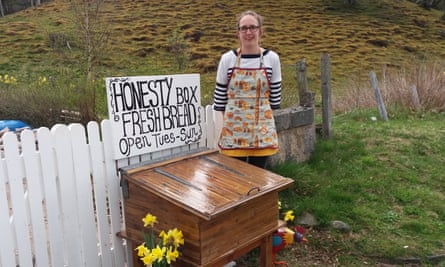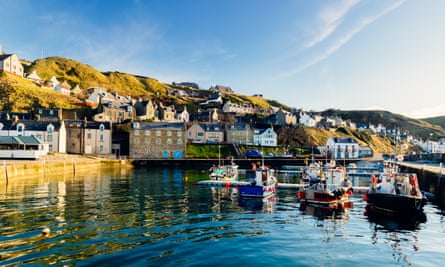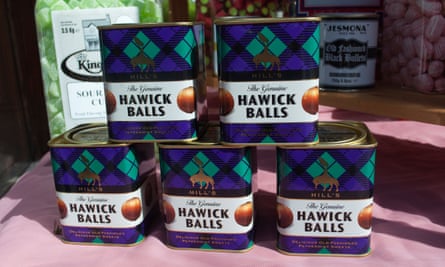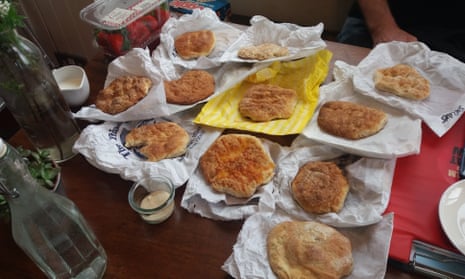Think of it as a Scottish version of Breakfast at Tiffany’s. The setting is a hardware shop in the pretty village of Ballater, gateway to the Cairngorms. Behind the counter is Alistair Cassie, AKA “Mr Ballater”, once television repairman to the Queen, now in his 70s and busy spreading Lurpak on a flat, flaky roll that he calls a “buttery”. “That’s damn good eating,” he says.
Enter the first customer of the morning, a stout Englishman in a camouflage hat. “What is a buttery?” he asks. “Is it a Ballater thing?”
A local greybeard, Colin, who introduced himself as the village idiot (“but I’ve got an awfa lot of competition”) sighs as if such ignorance pains him. But it’s not such a daft question. What is a buttery? It’s the characteristic staple of north-east Scotland, as much a part of the local identity as the lush green landscape and the Doric dialect. If you visit Aberdeenshire and do not eat butteries, you haven’t visited Aberdeenshire.
Flat, layered pastries, butteries look like roadkill croissants and are made from butter, lard, salt, sugar, flour and yeast. “Evil bricks of tasty,” is the unimprovable description given by the film director Duncan Jones, who spent part of his childhood in Aberdeen.
I had brought my own bag of evil to Mr Ballater’s shop. I’d picked it up from Highlanders Bakehouse in Crathie, by Balmoral Castle. Shona Jamieson, a Cordon Bleu-trained chef, has returned to her native north-east and started a bakery, selling butteries at an honesty box for 50p each.

Aberdeenshire is full of wee bakers, and a buttery odyssey is a fine way to explore the area, heart gladdening and arteries hardening as you go.
Local musician Ian Shand, known as Piper for his bagpipe skills, is wearing a T-shirt printed with the logo of Aitkens, the bakery he prefers; every buttery eater has their favourite. Piper once contributed to a song celebrating Aitkens; it runs to 42 verses, and he is minded to add a 43rd, turning the song from ode to eulogy as the business has been reported to be closing. This, for buttery addicts, is a blow.
“One of my pals has had a triple heart bypass and has been told by the doctor to stop eating them,” says Piper. “But he can’t. He’s like an alcoholic with rowies.”
Rowies. That’s what they call them in Aberdeen. There is a linguistic divide between city and shire: as one aficionado puts it, “The toonsers ca’ them rowies and the teuchters ca’ them butteries.”
Aberdeen is where I’m headed next. The city sparkles in the sun, a glitter of mica in the granite. Martin Gillespie of Slow Food Aberdeen lays out 11 butteries – sorry, rowies – on a cafe table to demonstrate the variety: “Smiths of Huntly, Sinclairs of Rhynie, the Ythan Bakery in Ellon …” Gillespie recently organised a World Buttery Championships to raise awareness that rowies are “endangered heritage food”. He bemoans the way most big commercial bakers have swapped the butter and lard for palm oil. The tide may be turning, though. JG Ross, the largest manufacturer, plans to reintroduce the old recipe and offer a “traditional” buttery again.

From Aberdeen I head north-west, stopping to munch a buttery by the Maiden Stone. More than 1,200 years old, this Pictish monolith is one of the area’s great sights. Its carvings inspired the legend that it is the petrified form of a woman who lost a bet with the devil that she could bake bannocks faster than he could build a road. Perhaps she’d have had better luck with butteries. I munch mine (from Thain’s of Aberdeen, it’s devilishly greasy and salty) and move on.
North now, to Banff and the coast. The gorse is Van Gogh yellow; the sea is Yves Klein blue. I’m here to visit Granny Bakes, a bakery in the medieval part of town. “Granny” is Angela Wiseman. She has been known to post butteries to lard-deprived riggers out on the oil platforms. “Butteries evolved out of fishing folk at sea,” she explains. “They needed food that packed oomph: because it was high-fat and well-salted, it kept longer.”
I walk from Granny Bakes to the kirkyard at the foot of the road with its crooked gravestones, skulls and hourglasses and winged Death with a scythe. Generations of buttery eaters rest here. Loons and quines who knew that taste and what it meant: home. No doubt many would agree with the sentiments of Mr Ballater – damn good eating in a damn fine corner of the world.Great scoffs: more regional treats

Boiling in the Borders
The beautiful Scottish Borders, all rolling hills and ruined abbeys, are nowt without a boiled sweet to suck. Hawick Balls are wee pepperminty wonders. Soor Plooms, from Galashiels, is also the town motto. Jethart Snails, from Jedburgh, are mints derived from a recipe said to have been brought to Scotland by French prisoners during the Napoleonic wars. If you have any teeth left, try Berwick Cockles or Melrose Toffee. Sweeties should be eaten from a paper poke and bought, if possible, by the quarter-pound; the metric system has its place, but that place is not the Borders.
Get battered in Fife
The East Neuk of Fife, known for its pretty fishing villages, is also home to some of Scotland’s best places for a chippy tea. Anstruther Fish Bar is the best-known, but also in “Anster” is the Wee Chippy and the Boathouse. Some fickle locals, their appetites stronger than their town spirit, make the short journey south to the Pittenweem Fish & Chip Bar. The Crail Fish Bar is also highly regarded, or carry on north around the coast to St Andrews for Tailend and Cromars.
Mince around in Forfar
The great schism in the Angus town of Forfar is between folk who eat bridies from McLaren’s and those who prefer them from Saddler’s. A bridie, the characteristic food of the area, is a half-moon of shortcrust pastry filled with minced beef and sometimes onions. Both bakers are Victorian institutions. The preference in bridie is passed from father to son, mother to daughter, loyalty intensifying with each new generation. Forfarians, however, seem united in their belief that pies made in nearby Arbroath are inedible, though the fish suppers – they will admit, grudgingly – are all right.

Comments (…)
Sign in or create your Guardian account to join the discussion